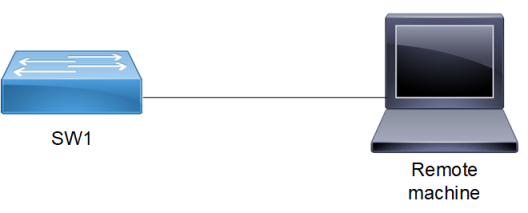SSH Key-Based Authentication
Enable OcNOS device SSH server to perform public key based SSH authentication, to enable machine to machine communication possible without requiring password. Public key based authentication increases the trust between two Linux servers for easy file synchronization or transfer. Public-key authentication with SSH is more secure than password authentication, as it provides much stronger identity checking through keys.
No support for Digital Signature Algorithm (DSA) public key authentication.
Topology
Figure 17. SSH Key-based authentication

Public Key Authentication Method
The server has the public key of the user stored; using this the server creates a random value, encrypts it with the public key and sends it to the user. If the user is who is supposed to be, he can decrypt the challenge using the private key and send it back to the server, server uses the public key again to decrypt received message to confirm the identity of the user. SSH is supported in-band (default VRF) and out-band (management VRF). Installed keys are stored in the ~/.ssh/authorized_keys file.
SSH key based authentication steps:
- Login to remote machine Linux desktop (ssh client) and generate the key pair using the
ssh-keygencommand. - Create the username in OcNOS device (ssh server).
- Install the public key of remote Linux ssh client in the OcNOS device.
- Display the installed key in the OcNOS device using the
show running-configcommand. - Log in from the remote Linux ssh client to the OcNOS device without providing a password.
Useful Commands on Remote Desktop Client
|
# ssh-keygen |
To generate key pair on remote Linux machine (ssh client) |
|
# cd /bob/.ssh/ |
To go to the location of saved key pair |
|
# cat id_rsa.pub |
Command to display the generated public key in remote Linux client |
Configuration commands in OcNOS
|
(config)#configure terminal |
Enter configure mode. |
|
(config)#feature ssh vrf management |
Enable the SSH feature on vrf management. To enable in default vrf give the command "feature ssh" |
|
(config)#username fred |
To create username with default role as network-user. To create user with different role specify role using command "username <username> role <role_name> |
|
(config)#username fred sshkey ssh-rsa AAAAB3NzaC1yc2EAAAADAQABAAABAQC8XhFiGlZP6y Y6qIWUkew884NvqXqMPSOw3fQe5kgpXvX0SbcU15axI /VHVgU2Y0/ogAtRUlAk5soRrf5lZ2+rT0zNP37m+Tm5HIEFKZZut0 FffGSuXtPKbE+GGlQYHEzC8RSnqQuHlxrlve3lGbB1U UxuWhMzJfgc2vZ78V2znd2zk4ygiN1jx1sE8UI98WyI cwuq44tzuIaUYAICIfrQJXriQml+QcJ9NER5O8rMS5D 5NnTVh1nroqoozY8i/qMKfhCFMbysjiDMHU9GclNsNbIF 6Cy3csoTncw0vyXV bob@localhost.localdomain |
Install the public key of remote Linux client in OcNOS device. |
|
(config)#commit |
Commit the candidate configuration to the running configuration |
|
(config)#exit |
Exit configure mode. |
Validation
The new cipher encryption algorithm takes effect for a new incoming ssh client connection.
#show running-config
feature ssh vrf management
username fred role network-user
username fred sshkey
ssh-rsa AAAAB3NzaC1yc2EAAAADAQABAAABAQC8XhFiGlZP6yY6qIWUkew884NvqXqMPSOw3fQe5kgpXvX0SbcU15axI/VHVgU2Y0/ogAtRUlAk5soRrf5lZ2+rT0zNP37m+Tm5HIEFKZZut0FffGSuXtPKbE+GGlQYHEzC8RSnqQuHlxrlve3lGbB1UUxuWhMzJfgc2vZ78V2znd2zk4ygiN1jx1sE8UI98WyIcwuq44tzuIaUYAICIfrQJXriQml+QcJ9NER5O8rMS5D5NnTVh1nroqoozY8i/qMKfhCFMbysjiDMHU9GclNsNbIF/DQbvWEskFFEvf6fOrzXyvq26NpgaJnZ4pQVzgkOaVw16Cy3csoTncw0vyXV bob@localhost.localdomain
<skipped other content>
#show running-config ssh server
feature ssh vrf management